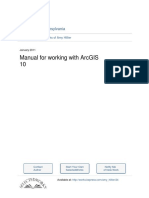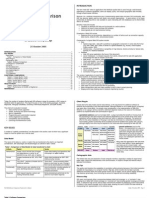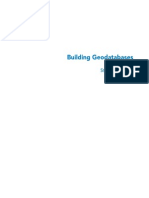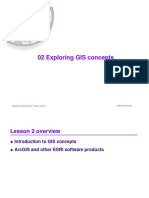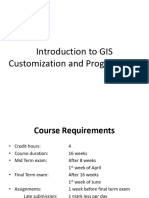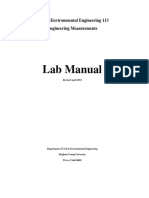0 ratings0% found this document useful (0 votes)
688 views390 pagesGIS Tutorial 3 - Advanced Workbook (PDFDrive)
Uploaded by
denysadeCopyright
© © All Rights Reserved
We take content rights seriously. If you suspect this is your content, claim it here.
Available Formats
Download as PDF or read online on Scribd
0 ratings0% found this document useful (0 votes)
688 views390 pagesGIS Tutorial 3 - Advanced Workbook (PDFDrive)
Uploaded by
denysadeCopyright
© © All Rights Reserved
We take content rights seriously. If you suspect this is your content, claim it here.
Available Formats
Download as PDF or read online on Scribd
You are on page 1/ 390
Pe eS)
_ |
GISTUTORIAL
Advanced Workbook
David W. Allen
Jeffery M. Coffey
Contents
Designing a framework for the complex geodatabase
Chapter 1: Designing the geodatabase schema 1
Tutorial1-1 Creating a geodatabase—building a logical model 2
Exercise 1-1 16
Tutorial 1-2 Creating a geodatabase—expanding the logical model 20
Exercise 1-2 28
Chapter 2; Creating ageodatabase 33
Tutorial 2-1 Building ageodatabase 34
Exercise2-1 SI
Tutorial 2-2 Adding complex geodatabase components 55
Exercise2-2 64
Chapter 3: Populating ageodatabase 69
Tutorial 3-1 Loading data into a geodatabase 70
Exercise 3-1
Tutorial 3-2 Popuilating geodatabase subtypes 81
Exercise 3-2 89
Working with data
Chapter 4: Working with features 93
Tutorial 4-1 Creating newfeatures 94
Exercise 4-1 109
‘Tutorial 4-2 Using context menu creation tools 112
Exercise 4-2
Tutorial 4-3. Exploring different creation tools 131
Exercise 4-3 140
‘Tutorial 4-4 Using coordinate geom
Bxercise4-4 155
‘Tutorial 4-5 Georeferencing and tracing 158
etry 143,
Exercise
Ps
GIs TUTORIAL 3
Chapter 5: Working with topology 175
Tutorial 5-1 Setting up map topology 176
Exercise 5-1 183,
Tutorial 5-2 Creating geometric networks 186
Exercise 5-2 207
Tutorial 5-3 Setting up geodatabase topology 210
Exercise 5-3 230
Chapter 6: Customizing the interface 235
Tutorial 6-1 Customizing toolbars and menus
Exercise 6-1 243
Tutorial 6-2 Creating toolbar scripts 246
Exercise 6-2 258
Chapter 7: Automating processes 261
Tutorial 7-1 Getting started with ModelBuilder 262
Exercise 7-1 272
Tutorial 7-2 Expanding model capabilities 275
Exercise 7-2 284
Tutorial 7-3. Creating model documentation 287
Exercise7-3 296
Using advanced techniques for labeling and symbolizing
Chapter 8: Developing labels and annotation 299
Tutorial 8-1 Labeling with Maplex 300
Exercise8-1 319
Tutorial 8-2 Adding geodatabase annotation 321
Bxercise8-2 339
Exploring cartographictechniques 343,
Tutorial 9-1 Building cartographic representations 344
Exercise 9-1 368
Tutorial 9-2 Creating acustom legend 370
Exercise9-2 382
Preface
‘The study of geographic information systems (GIS) isa wide-ranging topic, and
[ArcGIS software covers an extensive technology. There are many books written
about how the software works and how it can be used to manipulate data and
solve spatial problems. So, the task becomes defining where this book fits into
your educational cycle of learning all you can about GIS.
GIS Tutorial 3: Advanced Workbook concentrates mainly on features of the
Arelnfo and ArcBditor licenses of ArcGIS that are not available at lower license
levels. While it may seem on the surface to jump from topic to topic, remember
that iis not trying to demonstrate basic software features—there are lots of
books that do that. Its instead designed to instruct you on the use of the more
complex functions of the software. Incorporating these into your daily workflow
will help make your job alittle easier and your maps a little better. You should
be familiar with the skill sets learned in GIS Tutorial 1 and GIS Tutorial 2 and
have experience working with shapefiles, feature datasets, and feature classes
in ArcMap.
futorial 3: Advanced Workbook contains nine chapters, each containing
tutorials and exercises that build pertinent skills. A task index is included to
help you locate relevant ArcGIS tasks and tools within the book. Instructors
will find data, a course syllabus, and teacher guides on the instructor DVD
available upon request from wuw.esri.con/esripress. All 23 tutorials and
related exercises can be covered in a fast-paced 16-week semester. Instructors
may also select chapters that are most relevant to their program and complete
those chapters at a slower pace during the semester.
‘The first part of the book, containing three chapters, explo n designing schemas and
creating data from scratch, Many other books start with premade datasets and instruct you on how
‘to manipulate and expand the data to accomplish something, but where does this data come from?
Predesigned database schemas are also available that can be used as templates for your datasets. While
these can be a great starting point, there will ultimately be changes that you will want to make. Only by
fully understanding the process of designing database schemas will you be able to make changes that
ensure the best and most efficient use of the geodatabase. There are also situations where a premade
data schema is not available for the geodatabase you need. Has anyone, for example, done the definitive
design on routing a street sweeper and recording its progress? If given this project, you would have to
design and create the schema yourself. In chapter 1, you will learn how to design a functional, efficient
geodatabase, and in chapter 2, you will create it. Chapter 3 shows how to bring existing data into a complex
geodatabase that you create.
Part 2, which contains two chapters, deals with creating new features in the ArcMap environment. The
editing and topology tools in chapters 4 and 5 can be used to take advantage of the geodatabase design
and make the best use of the data integrity rules, There ave also many techniques shown to speed up the
creation process, sometimes to the point of having the software create features for you, By using these,
the resulting data not only will be more accurate, but may also be easier to maintain in the future,
Part 3, containing two chapters, deals with managing workflows in ArcGIS. The use of custom tools,
scripts, and custom toolbars explored in chapter 6 can make you much more successful in your edit
ing tasks. Bven the simplest customization might save several keystrokes or mouse clicks, resulting in a
time savings. More complex techniques, such as scripts written with the Python programming language,
will have a bigger impact on your workflow. Chapter 7 shows how to automate your workflow in a visual
scripting environment called ModelBuilder, where you can develop custom tools with the look and feel of
standard ArcGIS tools,
Part 4, containing two chapters, is aimed at helping you use the more advanced cartography tools
available in ArcGIS. Chapter 8 deals with advanced labeling techniques and annotation, while chapter 9
concludes with ways to customize your legend and make the most of cartographic representations to
draw advanced symbology, The end result will be a map that is more engaging—one that presents your
ideas and analysis clearly and concisely
‘The set of skills covered in this book should take you beyond the basics and introduce you to tools and
methods that use the best features of the higher license levels of ArcGIS.
This book comes with a DVD containing exercise and assignment data, and a DVD containing a trial
version of ArcGIS Desktop 10, You will need to install the software and data in order to perform the
exercises and assignments in this book. (If you have an earlier version of ArcView, ArcEditor, or Arcinfo
installed, you will need to uninstall it) The ArcGIS Desktop 10 DVD provided with this book will work
for instructors and basic-level students in exercise labs that previously used an ArcView license of ArcGIS
Desktop. Instructions for installing the data and software that come with this book are included in
appendix D.
For teacher resources and updates related to this book, go to www-esri.con/esripress
Acknowledgments
David W. Allen: I get alot of students in my GIS classes at Tarrant County
College in Arlington, Texas, who have been working in the GIS industry for
years and have picked up GIS skills along the way. These students have greatly
benefited from structured training on some of the more advanced tools in
ArcBditor and Arcinfo, which prompted me to write this book. Jeff Coffey of
the Tarrant Regional Water District in Fort Worth came on board to help polish
this into a complete package, and Judy Hawkins of ESRI Press helped us get the
manuscript noticed, A debt of gratitude goes out to each of them, as well as to
all the students who have suffered through my classes over the years. It was
their puzzled looks and questions that prompted me to rewrite sections of the
manuscript to offer better explanations and clearer instructions.
’d also like to thank Carolyn Schatz of ESRI Press, who edited this manuscript
Although she is not a GIS expert by trade, she would probably rival most of you
after having worked through these tutorials so many times. It’s a tough process,
but she made it very enjoyable, Other great people at ESRI Press include editorial
supervisor David Boyles; cartographer Riley Peake, who did the technical reviews;
and the rest of the ESRI Press production, marketing and distribution staff.
And finally, thanks to the City of Euless administration, which allowed its rich
GIS datasets to be used in the making of these tutorials. While the dat:
rrocesses are based on reality, all the scenarios are fictional and should not be
associated with the City of Buless.
nd
GIs TUTORIAL 3
Jeffery M. Coffey: Having worked in the public, private, and academic sectors utilizing GIS for 20-plus
years, limmediately recognized the benefits of developing a textbook aimed at students already well
acquainted with GIS technology but who seck a deeper understanding of some of the advanced applications
available with ArcGIS. I feel confident that this text will give students addition:
al insight and skills to
carry the application and use of GIS technology into the future. I would like to thank David Allen for
offering me the opportunity to help with this book, the excellent editorial staff support at ESRI Press,
my family at the Tarrant Regional Water District, and my girls at home—Robin, Morgan, and Ella
their patience and support.
Part 1
Designing a framework
for the complex geodatabase
Designing the
geodatabase schema
BED Designing the geodatabase schema GIS TUTORIAL 3 i =
Tutorial 1-1 |
Creating a geodatabase— building a
logical model
The past few releases of ArcGIS software have included many additions and
improvements to the data storage capabilities of the geodatabase file structure.
There are new techniques to control interaction with the data, assign a behavior to
it, and define relationships among datasets. In the design process, it is important to
understand these techniques in order to build the most efficient database possible.
Learning objectives
+ Outline geodatabase behavior
+ Integrate datasets
+ Model reality
+ Use ArcCatalog
Introduction
‘The goal of designing a geodatabase is to model the reality itis intended to represent. Many
characteristics, or behaviors, of the data can be included in a geodatabase using various
techniques. As the data modeler, it is your job to explore the capabilities of ArcGIS to make
the most efficient and flexible database possible. The time spent at the start of a project in
designing the geodatabase will reap rewards later by making the data easier to use and edit
and by presenting a better representation of reality
‘The first step is to study the reality that is about to be modeled. Look carefully and determine De
what features will need to be included in the geodatabase, In ArcGIS, everything is mod-
cled as points, lines, and polygons, so realistic characteristics will need tobe assigned to ie
these pleces
Next, look at how the data will be created. Will it be imported from anather source, collected
with field equipment, traced from aerial photos, drawn from su
from some other process?
vey data, or be derived
Designing the geodatabase schema
consider how this data will be used. Who will do the edits, and what que
xpected to support in the future? Knowing what will be asked of the data la
a great impact on what the design will look like now.
these things in mind, you can start to construct a logical data model. The mo
diagram your process outline and allow for updates and changes before the fin
committed to a geodatabase, There are many tools available to diagram geodat:
ing the Geodatabase Diagrammer available by download from the Ar:
p://arescripts.esri.con/), and available on the included DVD. This, ho
sires the purchase of additional software to run, so as an alternative, there are
i
oe aeaeng 8 gf
merece
enor frary. Pranic
atspreedsbleecet once
astra
A see, there ate ten or more acceptable field names for each of the fields necessary
dress geocoding. Look over the list to see what the choices are
m= the tables worksheet, write the following field names, field types, and aliases:
« Pre Type, Text, Prefix Type
* Pre_Dir, Text, Prefix Direction
Text, House Number
me, Text, Street Name
ext Type, Text, Street Type
Text, Suffix Direction
LI (Long Integer), ZIP Code
ds will add alot of functionality to the dataset that may be valuable later. You
the parcels in a certain subdivision, all the parcels that front a certain
= or use the House_Num field to put address labels on the map.
mentioned was the land-use code. This is a two- to
a that the city plane
eric code denoting how the land is currently being used. Add this to
= Designing the geodatabase schema GIS TUTORIAL 3
8 Onthe tables worksheet, add the field UseCode with the field type Text and the alias
Land Use Code. The data entered so far has had to do with information that the city planner
‘wanted. One more piece of data will be necessary for you to maintain a connection to cer-
tain third-party data that is important to the project. The identity of the property owner is
not stored in the parcel’ attribute table but is stored in an external table. You will need to
adda field to your data structure that will allow you to set up a relationship between it and
the external table. The procedure is discussed later, but for now, you will need to add a field
to accommodate the relationship. The field should be called Georeference and have a field
type of Text.
On the tables worksheet, add the field Georeference, with the field type Text and the
name Georeference.
Design for data integrity
‘The design looks pretty good, but imagine what will happen when people start putting data
in the table. If they were to leave the SubName field blank, there would be no way to iden-
tify the legal record of a piece of property. What about address number or land-use code?
Leaving these blank could create gaps in the data. On the other hand, not every street will
have a value for prefix type, so there will be instances where a space can be left blank and
still be correct.
‘One way to build data integrity rules into your table is to set the flag for allowing nulls, or
no value, for a field. If nulls are not allowed, ArcMap will produce an error for any records
entered without all the necessary values being provided. Perhaps, the person entering
the data accidentally skips the field during data entry or tries to enter data before all the
information is known. Either way, it could cause problems with your data.
The solution is to mark in the design table which fields are allowed to have nulls and which
must have a value entered
On the tables worksheet, mark the following fields to allow null values:
+ Pre_Type
+ Pre_Dir
© Suffix_Dir
Mark the remaining fields as not allowing null values. Another data integrity component
is the domain. A domain allows you to define a list of values for any text field or a range of
values fora numeric field. When data is entered, itis matched against the domain to see if
itis a valid value, This helps eliminate typos or inventive abbreviations. Imagine ten data
entry clerks all coming up with unique abbreviations for the land-use code Vacant. It might
StS TUTORIAL 3 Designing the geodatabase schema
(ort Sar)
be entered as VAC, V, Vent, or any number of misspellings. A query to find all vacant
property would be difficult. 1f a domain is applied to the field Use_Code with all the co
abbreviations, it would be impossible for anyone to enter a value that wasn't in the domain
‘The domain values will be entered on the domains worksheet, and you will note th:
domain to avoid confusion with subtype fields that may be entered later.
On the tables worksheet, note on the line for UseCode the name of a domain that will
contain the acceptable values for this field. Call it ParcelUseCodes and place a (D) in
front of it for domain,
Now turn to the domains worksheet and write the domain name ParcelUseCodes, a
jescription of Use Codes for Parcels, a field type of Text, and the type of domain as
Coded values.
in the Code column, write A1 with a description of Single Family Detached. Under
write A2 with a description of Mobile Homes. Continue down the form entering
st of the Use Code values from the accompanying list. Print more worksheets
A Condominiums ESMT Easement
4 Townhouses FH Commercial
Single Family Limited rR Industrial
5 Multifamily GOV Government
2 Duplex Pos Public Open Space
2 Triplex PRK Park
Quadruplex PROW Private Right-of- way
STF Developed City Property ROW — Right-of-way
acant City Property SCH School
r Water Utility Property UTIL Utility
Church vac Vacant
DID Designing ee ons cis uromaLa
oe ae
Text [naed vel AL [saa Pony Detached]
I 2 [hob Homer
: = = an
ia Feombsses
5 [Sse Foil ed
7 = is a ey
it | ilex
co apie
a cl ‘einen
ETY evap ity Proper
{EET ona iy Property
(EETYW[Woter Ui Proper
(cal [Cneeh
EST [Essen
: z GN cere
Fe ina
| (207 |Gereriert
ros [rb Cpr Specs |
fax rar
3 [ROW rete Rho -woy
ROW [Right mey
Ise Somet
1 [or Toney
Vie Toco
Adding this domain will build in a check for data integrity. You can rest assured that the
use code abbreviation entered for any piece of property will fit your normal list. Perhaps
there are some other fields in the table that would benefit from the application of a domain.
Most of them, such as a subdivision name or house number, couldn't be constrained in this
way; there would be just too many values, But the field street type might be a good can-
didate, There is a standard set of street type abbreviations available from the U.S. Postal
Service, and from time to time, you may be asked to generate a mailing list from this table.
So, it would be a good idea to add a domain to this field.
There is a large number of acceptable street type abbreviations, and not only would you not
want to have to list them all on the domains form, but you also wouldn't want to type them
into adomain. Fortunately, there is a command to take a file listing of street types and read
them into a domain. That process will be demonstrated later, but for now, the information
about the file name can be recorded on the design worksheet.
6 On the tables worksheet, write StTypeAbbrv as the domain name for the field
Street_Type and add a (D) noting that it is a domain.
7 Next, go to the domains worksheet and write the name StTypeAbbry, a description of
Street Type Abbreviations, afield type of Text, and a domain type of Coded values.
srse sree ots TUTORIALS
B On the tables worksheet, write in anew field onthe bottom called Plat Status, male ts
feld typeI (short integer, give itan alias of Plat Status, and don't allow for null
values, Since most new property being added to the dataset will be platted, make its
‘lefault-value 1, Finally, write the name PlatSubtype for the subtype name with a
notation of (S).
Next, go to the subtypes worksheet. Write the name of the subtype as PlatSubtype and
add the three codes described previously:
+ 1=Platted Property
= 2+ Unplatted Property
+ 3 Plat Pending
—— i
PREGETDETAULTS
Domenene Debate
Pitted Property
red Property
Extend the data model
This concludes the initial design phase of the Parcels feature class, but there's another
component to investigate, When these polygons are symbolized, they can each have a solid
fil and a line style for their perimeter. When maps are made, however, the boundaries of
the parcels will need to be symbolized differently, The edge of the parcel that fronts a street
will be drawn with a thicker line; the edges representing property lines between propert
will need to be a thinner line; and in the event that someone owns two adjacent pieces of
property, the line between them should be dashed.
It isn’t possible to symbolize polygons that way, 60 a solution needs to be developed.
Consider creating a set of lines that will duplicate the boundaries of each parcel. Then these
lines can be symbolized as described. The only field the feature class will need is a code
describing which type of line to draw. This field would benefit from having a data integrity
rule (a domain) with the three categories of lines described.
Avbehavior will need to be set up between the polygons representing property and the lines
representing thelr boundaries. Ifthe shape of any polygon is modified, the lines will need
to automatically adjust to coincide. This type of relationship is called topology and will be
discussed later (see chapter 5). In order for ArcGIS to manage this topology, the feature
classes must reside inside the same feature dataset,
ase schema
1re datasets are another way to segregate data inside a geodatabase. If any bel
be built for a feature class, such as topologies, network databases, geometric net
ture dataset. Por this exam;
tionships, or terrains, they will have to reside in a fe
.dto establish a feature dataset for your feature classes, so that the
an be built.
responding
ology
On the feature classes worksheet, write the name of the feature dataset as ae
PropertyData. Next, write the new feature class name LotBoundaries on a blank line,
Give ita feature type of L (for line) and an alias of Lot Boundaries.
[Geocetanase name LandReconds:
et PrapertDete
POLY|Poreele Property Overship
{|
| [erieonaree lot Badan |
Next, go to the tables worksheet and write the name of the new table as LotBoundai
‘Then write the single attribute of this table, LineCode. Give it afield type of Text, add
an alias of Line Code, and do not allow nulls. Note that there is a domain for this field
and name it ParcelLineCodes.
Finish by filling in the information for the domain. On the domains worksheet, add the
name of the domain ParcelLineCodes, a description of Line Codes for Parcels, a field
type of Text, and note the domain type as Coded values. Then write the three domain
values described previously:
+ ROW=Right-of way
+ LOT=Lot Line
+ SPLIT= Split Lot Line
comsintpe oda Bese lad
Tpettbre [Street Type A [oded values] Batol Suffix rt
(StTypeAbbev Strat Type Abravitine
suit ne era [Tent eed vo
5 ler tart
= ms ius [Sp Une |
_oID Derigatog ha 0d cis TUTORIALS
Design a relationship class
“The features you've dealt with in the design so far have been the points, lines, and polygons
that will create the model of reality. Not all the data you will need for this model, how-
ever, is in the form of points, lines, and polygons. The design will also need to include
tabular data that is provided by an outside agency. For each parcel, there is ownership and
value information that comes from a county appraisal agency. This data would be valuable
for analysis if it were associated with the parcel data, The nature of the table is that itis
‘updated regularly from separate appraisal software, and because ofthis, it cannot be incor~
porated in the polygon feature class in the same way as regular data. By keeping it separate,
it will facilitate the maintenance of both the ArcGIS use of the data and the third-party
software's use of the data.
“Arelationship class has many of the benefits of a simple join in ArcMap but also provides
‘a mechanism for controlling edits in the related table. If the graphic features were altered
in an edit session, rules in the relationship class could also alter the related table and
‘maintain the relationship. For this example, the parcels have a match in the appraisal roll
table. If piece of property is removed because of replatting, the associated record in the
appraisal table can be set to be deleted automatically.
‘he final consideration is the cardinality of
the relationship. If each parcel has one and
only one match in the appraisal table, and
vice versa, the cardinality is said to be one
to-one (1:1). If one parcel can have several
‘matches in the appraisal table, such as the
case of a single parcel being owned by more
than one person, the cardinality is said
to be one-to-many (1:M). Ifthe opposite
relationship were also true—that is, an
owner can also own several pieces of prop-
erty—the relationship is said to be many
‘to-many (M:M).
‘Armed with this information, you can move to the worksheet on relationship classes and.
fill in the details.
On the relationships worksheet, name the relationship class Ownership. Record the
origin table as Parcels and the destination table as TaxRecords2010.
Designing the geodatabase schema
onships worksheet
Jationhip class: Ownership
weclass:Pareals
tablefeatue class: TaxRecords2010
‘ionship class can be used to add or delete records, but since the related table will
aged by another source, the relationship type should not allow records to be deleted,
‘ta simple peer-to-peer relationship. Labels will be shown to describe the relation-
.een the tables. The description for moving from the parcels feature cl
ble is Parcel is owned by and from the appraisal table to the parcels
ss is Owner has ownership of, As the relationship is used in analysis, these labels will
cxind the user of the nature of the relationship. Normally, relationship classes are trans-
arent (not visible to the user), but you can have ArcMap display a message when the
lationship is used. For this example, opt not to use them,
Circle Simple (peer to peer) as the relationship type and write the labels Parcel is owned
by for Origin to destination and Owner has ownership of for Destination to origin.
Circle None for message propagation.
Next, note the cardinality as many-to-many, since a parcel can be owned by several people,
done person may own several parcels. It may also be beneficial to store what percentage
nership can be attributed to each owner. This will help when more than one person is
.d as the owner. Write the name of the table as Ownership_Rel, and it will be added
the tables worksheet later. Finally, select the fields that will be the basis for the relation-
hip and give them a label describing their relationship to the related table (foreign key
scription).
Circle M-N for cardinality on your design
form, circle Yes under Attributes, and
write the name of the relationship
table as Ownership Rel. Set the Origin
and Destination primary key fields as
Georeference. Name the Origin foreign
key Owner and the Destination foreign
key Property.
Designing the geodatabase schema GIS TUTORIAL 3
4 Onthe tables worksheet, add anew table called Ownership_Rel with a field called
PercentOwn and a field type of Float. Write the alias as Percentage Owned, allow
for nulls, and set the default value of 100. This completes the logical model for the geo
database. From these design forms, you will be able to create the entire structure using
the ArcCatalog application and begin using it for storing data. If you do not have alot of
experience editing geodatabases, you may want to jump ahead to tutorial 2-1 and see
how this design will function, and then come back to this exercise. Otherwise, complete
this exercise, which will continue to focus on the design phase.
Exercise 1-1
‘The tutorial showed how to diagram a geodatabase to include feature classes along with their
associated tables, domains, and subtypes. The goal was to think through the design, adding data
integrity and behavior guidelines to the database
In this exercise, you will repeat the process for another dataset required by the city planner. This
one will contain the zoning data for Oleander. The zoning code for a piece of property determines
the type of development that is allowed on a particular parcel. The zoning districts may incorporate
several parcels and generally follow parcel boundaries.
The zoning districts will be represented by solid shaded polygons. The edges of the polygons will
need to be symbolized in one of two ways—either as a solid line representing a zoning boundary or
as.a dashed line representing a change in allowable development density. Because of this, you will
want to design a linear feature class for symbology purposes. The codes necessary for the zoning,
information are as follows:
‘Single Family Residential Heavy Commercial
Single Family Attached TH Townhouse
Single Family Limited u Limited Industrial
Duplex la Light Industrial
Triplex 12 Heavy Industrial
Quadruplex TX-121 121 Development District
Multifamily POS Public Open Space
Light Commercial
Designing the geodatabase schema
lescriptions of this data and determine what feature datasets and feature classes need
be made, what fields they should contain, any domains that might need to be created, and any
that might be beneficial
int a set of the geodatabase design forms as necessary.
1 the forms to create the logical model for feature classes for the zoning polygons 12
he zoning boundaries.
sstigate the use of domains and subtypes to build data integrity and behavior int
WHAT TO TURN IN
ou are working in a classroom setting with an instructor, you may be required to submit
forms you created in tutorial 1-1
leted geodatabase worksheets for
Tutorial 1-1
Exercise 1-1
thirty years, the manner in which geographic features have been portrayed, stored,
sed ceanipulated in GIS has evolved from a file-based technology into the present-day ESRI geo-
rmat. By using the ESRI geodatabase, GIS practitioners can more realistically manage
features and their velationships to other features. Although computer technology
ced the behavioral aspects of these relationships, the fundamental ways that these
features are represented —by points, lines, and polygons—has largely remained
|
;
|
B |
| Tutorial 1-1 review
ESRI geodatabase technology has improved the management of these points, lines, and
xy provicling tools to create geographic feature representations, enforce data integrity, and
tionships among the geographic features that more clasely model real-world situati
rated in the previous exercise, the opportunities to manage data using GIS methodology
nnhanced by careful thought and preplanning to ensure that an accurate portrayal of
features and their relationships is contained in the geodatabase. Preplanning the geo
ase is enhanced through the use ofa structured, organized logical data model to ensure
xy conceivable relationship is accounted for in the model. This p
lanning pha:
ar geodatabase than it is
wever, itis much easier to spend time at the outset designing y
hhange it once you've begun entering data into the model.
Organizing your geodatabase, through the use of feature classes and feature datasets, allows you to
refine relationships and behaviors for the data. Feature elasses, as the most basic representation
of geographic data in the geodatabase, can be logically grouped together to form feature datasets,
Although there are many different techniques for organizing geographic data in the geodatabase,
the organization of the data must be guided by the behavior of these features in the real world. For
example, if feature classes contained in the geodatabase work together to form a geometric network,
represent a terrain, or establish a topology, the feature classes must reside in the same feature
dataset. Such behaviors among the data must be considered while designing the geodatabase
‘Once your design is complete, using domains for your attribute data and other techniques will
reduce costly mistakes during the data entry phase of development of your geodatabase. Additional
techniques provided by the geodatabase such as the creation of subtypes optimize how data is
organized and used within the geodatabase. Through the use of the ESRI geodatabase, the many
tools available within ArcMap and ArcCatalog, and a thoroughly planned approach, your new geo-
database will adequately portray the geographic features and associated relationships among them.
Asa result, your model of reality as container geodatabase will represent the real-world
features as closely as possible
STUDY QUESTIONS
‘Whats a logical model of a geodatabase, and why should you develop a
logical data model when designing your geodatabase?
- What are the principal advantages of using subtypes? Give one example
of a situation where you would create a subtype and specify why.
}. What are the principal advantages of using domains?
|. What is the difference between feature classes and feature datasets?
When must you create a feature dataset?
Other real-world examples
Techniques described in this tutorial to create and manage geographic information in a geodatabase
can be applied toa wide variety of situations to successfully simulate real-world circumstances. Any
situation that involves finding and mapping the location of a person, building, or event will benefit
from a GIS approach.
‘Water utilities around the world use GIS methodology to help manage their infrastructure. Water
pipeline systems contain numerous components that often include pipe segments, valves, and
joints, as well as information on certain soil conditions around each pipe that affect pipe integrity. As
a GIS analyst, you may be tasked with the development of a geodatabase to represent each of these
features, as well as to model the critical behaviors and relationships of these components. All the
sal
UTORIAL 3 Designing the geodatabase schema
vill
ented by points, lines, and polygons, but to be successful, there
atures can be represt
1e geodatabase.
significant effort in duplicating the real-world relationships and behaviors in
also use GIS methodology to help manage vast networks of electrical grids. A
Electrical uti
sntories of all the assets in its
acipal use of GIS by a power company may involve developing im
cer grid. The inventory may consist of multiple types of power lines, power poles, and
shen relating to other assets as well as to customers
transform-
All these assets also have specific beha
ho rely on the network to provide reliable and cost-effective electricity. A properly designed geo-
Jase allows for the assessment of critical infrastructure features and provides an opportunity
accurately model the relationships and behaviors among the features in the geodatabase.
anagement tools available
-you become familiar with the advantages of the data creation and:
= the geodatabase, you will be able to simulate virtually any geographic s
uation and use these
be keeping
“ures to successfully manage the resulting geodatabase to your advantage whether it
satisfying customer demands, or any number of other G1S-related tasks.
k of utility asset
PRMEDIIITND <0 8st iee sem cis TUTORIAL 3
Tutorial 1-2
Creating a geodatabase—
expanding the logical model
“The components of a geodatabase can have various spatial relationships, or behaviors, that
form a topology. These behaviors can exist among points, lines, and polygons and will
have an impact on the logical model for a database. The most efficent designs will consider
topology from the beginning.
Learning objectives
+ Design linear feature classes
+ Investigate data behavior
+ Design for topology
+ Design point feature c
Introduction
The first tutorial used the geodatabase design forms to construct a logical design for a parcel
database. That dataset consisted of a polygon feature class along with
a linear feature class
to aid in symbolizing the parcel boundaries.
In this tutorial, you will design another set of feature classes to store data for a sewer
system. The process will include investigating the behavior of the data, and then trying to
accommodate it in the design
Remember to loo at how the data will interact with feature classes, as well as any possible
domains or subtypes that may be used. This will help to build not onl
ly an efficient design
butalso a good model of reality.
TORIAL 3 Designing the geodatabase schema @@Ygr eS m@esl
Designing the data structure
Seenario After your successes with the parcels and zoning datasets, the Oleander Public Works
Department is seeking your help to create a geodatabase for the sewer system. You will
need to design this for them,
Sewer systems are rather simple. They consist of pipes to carry wastewater to the treatment
plant, In real life it’s important that the pipes connect to ensure a direct flow route from
he beginning of the system to the end. In the data model, you will also want to ensure
connectivity, which will allow the data to be used later to construct a network dataset.
A great amount of data, such as the size of the pipe, the material it is made of, and the year
it was installed, can be stored as attributes of the linear features,
This portion of the process is intended to inspire thought and creativity. If done correctly,
your designs will be valuable for years to come. Once all the designs are completed, they
be used to create the data structure in ArcCatalog,
Peta Since you are creating this geodatabase from scratch, there is no data to start with. But you
need to print the geodatabase design forms on the DVD as an aid in the design process,
Dieteeed Geodatabase design forms
Bese the geodatabase design process
1e geodatabase design forms, you will once again commit your thoughts to paper
examine all aspects of how the data will be used, edited, and symbolized. The first part
of the design will be to name the geadatabase, Since the data, in all likelihood, will be used.
in network later, it will also require a feature dataset.
JL On the first page of a new set of design forms, write the name of the new geodatabase
Utility Data. On the next line, add the name of the feature dataset as Wastewater.
cer lines will be built as linear features, which will require a feature class. A number
utes could also be stored with the lines, as mentioned earlier. Add each of
forms.
D onthe geodatabase design form, write the name of the new feature class. Give it the
mame SewerLines with a feature type of L and an alias of Sewer Lines
ou will need to fill in the tables worksheet and show which fields the feature
contain, ‘The three fields that were required by Public Works were pipe size, which can
aber; pipe material, which can be text; and the year the pipe was installed, whi
aber
GIS TUTORIAL 3
Designing the geodatabase schema
On the tables worksheet, write the name of the feature class. Then write in the fields
PipeSize with a data type of SI, Material with a data type of Text, and YearBuilt with a
data type of LI. Add the aliases of Pipe Size, Pipe Material, and Year Built, respectively.
In Oleander, there are sewer lines that run through the city that belong to other agencies.
Some are the pipes of other cities and are headed for the treatment plant, and some belong
to the regional utility that handles all the wastewater treatment for local cities. They will
all need to be included in the dataset, and on the maps, to prevent accidentally digging into
them, The owner of the line needs to be recorded, so you'll adda field called Description to
store the name of the owner of each pipe.
In the field name column, add a field called Description. Write a field type of Text with
an alias of Owner.
Dipcice Jet [roe Si =
erarel ——[Text Pipe Rarer
Fsrbuly [Ut [eer out
Searptin [rea [omer :
Data integrity issues
With this data, itis important that every pipe have an entry for size and material. Year of
construction, however, may not be known for some of the older, existing pipes. Because
of this, do not accept null values for the fields PipeSize and Material, but allow nulls for
YearBuilt. Also, the ownership of every pipe must be known, so don't allow for nulls.
; For each field, write No next to the aliases Pipe Size, Pipe Material, and Description in
the Nalls column, Write Yes next to Year Built in the same column, The next data integ
rity issue willbe to investigate the use of domains. Sewer pipes vary in size from 6 inches
to 12 inches in 2-inch increments. Pipes larger than 12 inches are called interceptors and
are metered to determine the charge to the city. In Oleander, the interceptors are owned by
P EP wows pu Mqddy 22415 ‘wep
satgadjgramag ax uStsse 03 moxie uMop
-doxp ureuiog ayp asn ‘aued saysaadoza
Pree 249 ur pue Play ozigadig aq PND
"ae3 spretg 94 PEP Pure ssep> amyeaz
souypreaiag aya Jo sanzzadoad oy uado,
soep omaeay sourHaHi9g ya UE PPy
aargadig axp 01 pauilisse aq [pa ureuop ais
adid styy, “Mo 9pyP wexp pur ‘Aqddy yy
-uyewop ay 105 s9poo pur sroaurexed
sompo oy xoyUa pur ated sanqeA papod
3q9 03 paa20ig “sanzadoag ureuiog 243
asn{pe pue wor dynsap si pure wrewop ay
jo ouren oy zoyuo ‘OUT UE |G ISI ay UO
“qe surewiog ay} »prp pue asequiepoad
aed Ayn ays jo sapredosd oy uodo
poed v Supavery
Aen en
re
cis TvroRIAL2 ceomings geotatsvae QEEEEEGTIN
‘The second subtype is less complex, so for learning purposes, you should create that one
first. Then a more detailed description will follow to create the more complex subtype.
‘Right-click the SewerPixtures feature class, click Properties, and then click the
Subtypes tab. Use the drop-down arrow to set the subtype field to Fixlype.
Change the first code from 0 to Land enter
the description Manhole. Add a second
code of 2 with a description of Cleanout.
Click Apply, and then click OK.
Now to tackle the tougher subtype. This
one has codes and descriptions like the
other subtype but also includes a domain
and default setting for each subtype code.
Right-click the SewerLines feature class, click Properties, and then click the Subtypes
tab, Use the drop-down arrow to set the subtype field to Material.
Change the first code from 0 to 1 with a description of PX.C. Then in the Default Values
and Domains pane, enter the default values of 8 for PipeSize, 2010 for YeaxBuilt, and
Oleander for Description. Click Apply to check for errors. If thexe are any, correct them
before moving on.
On the next blank line, enter a code of 2 with a description of HDPE. Enter the default
values of 10 for PipeSize, 2010 for YearBuilt, and Oleander for Description. Click Apply.
Continue by entering a code of 3 and a description of DI on the next blank line. Enter the
default values of 12 for PipeSize, 2010 for YearBuilt, and Oleander for Description.
Click Apply.
B Close ArcCatalog.
Creating a geodatabase
7 Thelast two subtypes do not have any
additional default or domain params
ters. On the next two lines, enter codes
4 and 5 with descriptions of Conc and
Clay, respectively. Click Apply, and then
click OK. This wraps up the database cre-
ation process. All the components of the
logical model have been entered. On very
complex datasets, it's a good idea to run
back through the logical model and check
the entries against the feature classes to
make sure nothing was missed. If you were
methodical in the process, everything
should be OK.
Test the rules
‘As in the last tutorial, it would be advisable to test the features in ArcMap before proceeding,
‘This quick pilot study will determine if any of the rules are not working and will give you
the chance to go back into the data structure and correct them if necessary. Once data is
loaded into the feature classes, it would be much riskier to try and fix problems, especially
if this involved deleting and re-creating afield.
1. Start ArcMap and open Tutorial 2-2.mxd.
Add the feature dataset Wastewater from
the Utility Data geodatabase to the table
‘of contents, and zoom to the bookmark
Starting Extent, All the feature classes in
the Wastewater feature dataset should be
added to the table of contents. Notice that
the layers Sewer Fixtures and Sewer Lines
have already been classified by their sub-
type values. ArcMap does this automatically,
although if this is not the desired classifica-
tion, it can be changed manually.
ealether vates>
Materia
dey
—cone
—o
GIs TUTORIAL 3
Ss rvrToRIALs
2. Goto Editor > Start Editing. The Create
Features template will display all the
features that can be edited, grouped by
feature class and subtype. Select PV.C.
from the Sewer Lines listing. Notice that _|_ttstewrs
the lst of selections under Sewer Fixtures ser
and Sewer Lines comes straight from the soveitues
subtypes you defined earlier. |
B Use the default construction tool in the
map area to draw a sample line, com-
plete it by double-clicking the last point,
and open the Attributes dialog box from
the Editor menu, Notice in the Attributes
dialog box that all the fields have already
been filled in! These are the default values
that you defined in the layer properties. For
the sewer line type of PY.C,, the default
size is 8", the year built is 2010, and the
description regarding ownership of the line
is set to Oleander.
Poe see ¢
‘Poets Pac
oar at 2ni0
ner ‘lender
SHAPE Lanath
FOUR TURN
‘Dem cach of the types of sewer lines and notice the attribute values assigned to each one.
er that the defaults apply only to new items drawn. Since concrete and clay pipes are
sestalled as new, there are no defaults set for these. They need to appear in the database,
“Gevweves, to accommodate existing pipes made of these materials. If they were not in this list,
‘Sey would test as invalid when the database is checked.
y
<<
Creating a geodatabas GIs TUTORIAL 3
When you have finished looking atthe various sewer lines, close ArcMap without saving
edits or the map document. This was a quick test of the data structure. If any errors were
found, you could go back and correct them in ArcCatalog, but be sure to close ArcMap
first before making any corrections. If you wish to delete incorrect entries from the
Attribute table, start an edit session in ArcMap, highlight the bad entries, and press Delete.
Remember that once data is added to these feature classes, it will be more difficult to
change the data structure after the fact.
Exercise 2-2
‘The tutorial showed how to create a geodatabase and all its components from the logical model,
This included a feature dataset, feature classes, domains, and subtypes.
In this exercise, you will repeat the process using the logical model for a storm drain system created
in exercise 1-
+ Start ArcCatalog and locate the MyAnswers folder
+ Use the geodatabase worksheet to create the geodatabase.
+ Use the tables worksheet to create the feature classes with the correct fields
+ Use the domains worksheet to create and apply the domains,
+ Use the subtypes worksheet to create the subtypes.
WHAT TO TURN IN
If you are working in a classroorn setting with an instructor, you may be
required to submit the materials you created in tutorial 2-2.
‘Screen capture of ArcCatalog showing all the components of the completed
geodatabases
‘Tutorial 2-2
Exercise 2-2
‘GIS TUTORIAL 3
Tutorial 2-2 review
‘This exercise built on the concepts of creating unique attribute domains and subtypes for linear
features, The City of Oleander is managing its sewer network in a geodatabase, As you can see, the
‘same process that was used for setting up domains and subtypes for parcels was used for the sewer
system, By using the standardized planning process and filling out the forms ahead of time, you
‘were able to simplify creation of the geadatabase for the sewer system.
“ArcCatalog provides all the necessary tools to easily create your geodatabase; however, careful
bought was necessary to help establish the behaviors and relationships for these features. As you
“could see, separate feature classes could have been created for the different materials of pipes and
‘Extures, However, regardless of the material of pipe or fixture, each one has the same basic func~
“Sen and could be managed more efficiently through the creation of subtypes based on material.
“Geng subtypes to define categories of features in this manner is common in the industry to distin-
‘behavior, attributes, and access properties of features. A domain was created for the size of
ewer pipes to help with the standardization of these values in order to enforce data integrity.
syou have worked through the tutorials, you have probably noticed that there has always been a
to test each component that you built into your geodatabase to ensure that itis representing
features as the needs of the project dictate. This QA/QC exercise is a critical step that should be
fed as often as possible throughout the development project. QA/QC of your database devel-
st project should not be skipped because of time constraints, or for any other reason. There
‘sothing worse than completing the construction of a project and realizing that it does not ade-
aly meet the needs of your client because of a logical oversight or because an error was made
fn the development process. Typically, these situations can surface in two different ways that
‘can help control with thorough planning: Either the features, attributes, behaviors, access
ctions, and so forth, built into the model do not adequately support the workflow process they
designed to support; or errors were made in the execution of the plan. It’ really pretty simple.
2 failure occurs, you either have a bad model or poor execution. (Of course, this is assuming
the workflow process itself is designed adequately to achieve the necessary results. Most likely,
sill have no control of the process that you are hired to support).
‘you succeed with your database design project, make sure to do the following: (1) meet with
{2ocument your interviews with project sponsors to discern the necessary requirements for
‘eroject, (2) have the project sponsor review and approve the project requirements document
"you compiled, (3) use the geodatabase design forms to carefully think through an appropriate
that reflects the approved results from your requirements session, (4) review your design
‘the project sponsor and get his or her approval of your proposed design, (5) carefully exe-
syour plan of developing your geodatabase, (6) conduct testing to ensure that your geodatabase
‘your requirements, and finally (7) implement your geodatabase.
You might also like
- GIS Tutorial 2 - Spatial Analysis Workbook100% (1)GIS Tutorial 2 - Spatial Analysis Workbook337 pages
- Introduction To Geoprocessing Scripts Using Python50% (2)Introduction To Geoprocessing Scripts Using Python257 pages
- Exercise: Use Satellite Data To Map A Land Cover TypeNo ratings yetExercise: Use Satellite Data To Map A Land Cover Type22 pages
- Section1 Exercise1 Perform Data Engineering TasksNo ratings yetSection1 Exercise1 Perform Data Engineering Tasks18 pages
- Exercise: Explore Data Using Data Visualization TechniquesNo ratings yetExercise: Explore Data Using Data Visualization Techniques41 pages
- Section1 Exercise1 Perform Data Engineering Tasks PDFNo ratings yetSection1 Exercise1 Perform Data Engineering Tasks PDF25 pages
- Create, Share, and Consume Great Maps With ArcGIS Online Presentation100% (2)Create, Share, and Consume Great Maps With ArcGIS Online Presentation27 pages
- Spatial Statistical Data Analysis For Gis Users100% (2)Spatial Statistical Data Analysis For Gis Users928 pages
- Geographic Information System and Its Applications: Presented by Dr. Varun Singh Associate Professor September 27, 2018No ratings yetGeographic Information System and Its Applications: Presented by Dr. Varun Singh Associate Professor September 27, 201878 pages
- Spatial Data Science MOOC Section 6 Exercise 2 - Communicate Your Analysis Using ArcGIS StoryMapsNo ratings yetSpatial Data Science MOOC Section 6 Exercise 2 - Communicate Your Analysis Using ArcGIS StoryMaps16 pages
- Section6Exercise1 MakingPredictions ParticulateMatterExposure PDFNo ratings yetSection6Exercise1 MakingPredictions ParticulateMatterExposure PDF66 pages
- Introduction To GIS Programming and Fundamentals With Python and ArcGIS100% (9)Introduction To GIS Programming and Fundamentals With Python and ArcGIS381 pages
- Building A Geodatabase ArcGIS 9 Editors of Esri Press Kindle & PDF Formats100% (3)Building A Geodatabase ArcGIS 9 Editors of Esri Press Kindle & PDF Formats171 pages
- Geodatabase Workbook ArcGIS 9 Editors of Esri Press No Waiting TimeNo ratings yetGeodatabase Workbook ArcGIS 9 Editors of Esri Press No Waiting Time116 pages
- (Ebook PDF) Mastering ArcGIS Pro by Maribeth Price Download100% (7)(Ebook PDF) Mastering ArcGIS Pro by Maribeth Price Download47 pages
- (Ebook) Geodatabase Workbook: ArcGIS 9 by Editors of ESRI Press ISBN 9781589480933, 1589480937 Complete EditionNo ratings yet(Ebook) Geodatabase Workbook: ArcGIS 9 by Editors of ESRI Press ISBN 9781589480933, 1589480937 Complete Edition154 pages
- Getting To Know ArcGIS Pro 2.6 Third Edition Law DownloadNo ratings yetGetting To Know ArcGIS Pro 2.6 Third Edition Law Download127 pages
- 02 Exploring Gis Concepts: Introduction To Arcgis INo ratings yet02 Exploring Gis Concepts: Introduction To Arcgis I25 pages
- Getting To Know ArcGIS Pro 2.8, Fourth Edition Michael Law Instant Download100% (1)Getting To Know ArcGIS Pro 2.8, Fourth Edition Michael Law Instant Download43 pages
- Resources For Learning Arcgis 10: New Titles For Users With Different NeedsNo ratings yetResources For Learning Arcgis 10: New Titles For Users With Different Needs1 page
- UWE Civil and Environmental Engineering Windfarm Prac Instructions (EngComm)No ratings yetUWE Civil and Environmental Engineering Windfarm Prac Instructions (EngComm)12 pages
- Lab Manual: Civil & Environmental Engineering 113 Engineering MeasurementsNo ratings yetLab Manual: Civil & Environmental Engineering 113 Engineering Measurements105 pages
- Population Mobility and Its Implications in Territorial Reconversion. A Case Study: The Crisul Repede Valley Tpu (Territorial Planning Unit)No ratings yetPopulation Mobility and Its Implications in Territorial Reconversion. A Case Study: The Crisul Repede Valley Tpu (Territorial Planning Unit)9 pages























